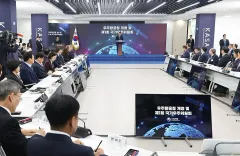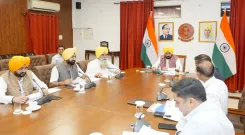Did HAL Win the Bid to Manufacture India’s Small Satellite Launch Vehicle?

Synopsis
Key Takeaways
- HAL wins the bid for SSLV manufacturing.
- Technology transfer from ISRO is a significant milestone.
- Comprehensive training will be provided to HAL personnel.
- The objective is to launch two SSLVs within two years.
- This marks a pivotal moment for India's commercial space sector.
New Delhi, June 20 (NationPress) Hindustan Aeronautics Limited (HAL) has successfully secured the contract to produce India’s Small Satellite Launch Vehicle (SSLV), as revealed in an official announcement on Friday.
The Indian National Space Promotion and Authorization Centre (IN-SPACe) has designated HAL as the recipient of SSLV technology from ISRO.
This development represents one of the most extensive technology transfers from ISRO to a commercial entity in India, facilitated by IN-SPACe, according to the statement.
A Technology Transfer Agreement will be formalized between HAL, NewSpace India Limited (NSIL), ISRO, and IN-SPACe. This agreement will include comprehensive training and support for HAL personnel by ISRO teams at both ISRO and HAL facilities, aimed at achieving the launch of two SSLVs over the next two years.
The evaluation process involved a detailed review of various technological and financial readiness aspects. After several months, HAL was selected as the highest bidder to obtain and operationalize SSLV technology.
IN-SPACe chairman Pawan Goenka stated, “With this technology transfer agreement, HAL will gain the capability to independently construct, own, and commercialize SSLV launches.”
“As India aims to realize a $44 billion space economy by 2033, establishing a strong public-private partnership model is crucial. The transfer of SSLV technology signifies a landmark moment in India’s evolving commercial space sector, being one of the first instances where a space agency has transferred complete launch vehicle technology to a company,” Goenka elaborated.
HAL will receive extensive training and support from ISRO at both organizations' facilities, aimed at achieving the anticipated launch of two SSLVs from an Indian launch site.
“We're aiming to complete this entire process within two years following the signing of the Technology Transfer Agreement,” said Rajeev Jyoti, Director of the Technical Directorate at IN-SPACe.
HAL chairman D.K. Sunil expressed, “We look forward to collaborating closely under the guidance of ISRO and IN-SPACe to ensure phased progress and achieve the ultimate goals. We are confident in fostering a cohesive ecosystem that supports increased small satellite launches from India’s ports.”









